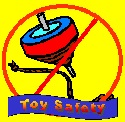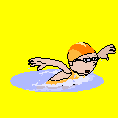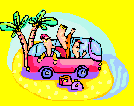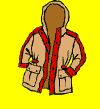Click on the links to view safety information about
biking:
Sick Kids study shows bicycle
helmet legislation leads to fewer bicycle-related head injuries in
children
Consumer Product Safety
Commission's Ten Tips for Safe Biking.
Health Canada Tips on wearing
a Helmet
Reminder from CPSC about the
importance of wearing a helmet.
Sick Kids study shows bicycle helmet
legislation leads to fewer bicycle-related head injuries in children
TORONTO - Research at The Hospital for Sick Children (HSC) and the
University of Toronto (U of T) has shown that provinces which have
adopted mandatory bicycle helmet legislation have had a significant
reduction in the number of bicycle-related head injuries in children.
This research is reported in the November issue of the scientific
journal Pediatrics.
The study looked at data on the 9,650 Canadian children (five to 19
years of age) hospitalized for bicycle-related injuries from 1994 to
1998. The results indicate that the bicycle-related head injury rate
declined significantly (45 per cent reduction) in provinces where
legislation had been adopted compared to provinces and territories that
did not adopt legislation (27 per cent reduction).
"It was already known that bicycle helmet legislation is a
successful strategy for the adoption of helmets, but the effect on the
rates of head injuries was unknown. This research shows that helmet
legislation is an effective tool in the prevention of childhood
bicycle-related head injuries," said Alison Macpherson, the study's
lead author, a U of T graduate student and a research fellow in HSC's
Department of Paediatric Medicine.
"Head injuries have devastating results and sometimes even minor
head injuries have long-term consequences. As parents and as a community
we want to do everything we can to protect our children. Provinces that
haven't adopted legislation need to revisit this issue," added
Macpherson, a recipient of an Emergency Health Services Fellowship from
the Ontario Ministry of Health and Long-Term Care.
In Canada, five provinces (British Columbia, Alberta, Ontario, New
Brunswick and Nova Scotia) have adopted bicycle helmet legislation.
"Safe Kids Canada supports bicycle helmet legislation as a
proven strategy, in conjunction with sustained education and enforcement
programs, to prevent head injuries and deaths. We also support the need
to provide safe environments for cyclists, such as the development of
bike paths and designated lanes, along with traffic calming measures, as
an important means of protecting cyclists from motor vehicle
traffic," said Rita Mezei, Public Policy and Advocacy specialist at
Safe Kids Canada.
NOTE: www.hotelfun4kids.com
is proud to be a Safety Partner with Safe Kids Canada.
Ten tips for safe bike riding from the
Consumer Product Safety Commission:
1. Always wear a bike helmet.
2. Stop and check traffic before riding into a street.
3. Don't ride at night.
4. Obey traffic signs and signals.
5. Ride on the right-hand side of the street.
6. Check your brakes before riding.
7. Give cars and pedestrians the right-of-way.
8. Wear light or bright-colored clothing so that motorists
can see you.
9. Be extra careful turning left - motorists don't expect
it.
10. Avoid broken pavement, loose gravel and leaves - which
can cause you to lose control of your bike.
Click here to return to Top

Health Canada provides the following guidelines for Helmet
Safety:
Bike injuries can happen anywhere, anytime. Stay
alert!
- A helmet must fit correctly to protect your head.
- Replace helmets at the first sign of damage.
Second-hand bicycle helmets should not be used. Even a
tiny crack makes it useless.
- Teach children how to adjust their helmets to fit
snugly.
- No baseball caps, please. Helmets protect less if
worn over a hat or bandana.
- Look for the Canadian Standards Association (CSA)
label inside the helmet.
- Make it a house rule - "Use a helmet for every
trip!"
- Teach your kids the "rules of the road".
- Keep approved helmets near bikes and trikes so your
children will always put them on.
- Set an example. Wear your helmet every time you
ride!
- Small child? Small bike! Make sure it fits.
Click here to return to Top

CPSC Reminds Bicyclists to "Use Your Head by
Wearing a Helmet"
WASHINGTON, D.C. - The U.S. Consumer Product Safety
Commission (CPSC) has been reporting for years that
wearing a helmet while riding a bike can save your life.
Cole Kertz, an 8-year-old from Bloomington, Ill., can now
vouch for this first-hand. Doctors tell him if he had not
been wearing his helmet, he would have died last summer
when he crashed into a pole while riding his bike. Even
with the helmet, he suffered a severely broken jaw, which
had to be wired shut to heal.
Cole is better now and using his experience to spread the
word about how important bike helmets can be. "Some
of the other kids at school didn't used to wear
helmets," said Cole. But after his return to school
last fall with the injury still healing, and after hearing
the story of how his helmet saved him, Cole thinks it has
convinced his friends to always wear a helmet. "I
guess they thought, 'I don't want to die.' "
"Each year, about 900 bicyclists do die, and more
than a half- million bike riders are injured seriously
enough to go to hospital emergency rooms," said CPSC
Chairman Ann Brown. "Use your head by wearing a
helmet, like Cole did. It can not only reduce the severity
of head injuries suffered by bicyclists, it can save your
life."
According to a survey released in 1999 by CPSC and the
McDonald's Corp., only about 50 percent of bicycle riders
in the U.S. regularly wear bike helmets. Of the estimated
80 million bike riders, 43 percent never wear a helmet and
7 percent wear helmets less than half the time.
CPSC is participating in a national strategy to make it
safer for bicycle riders to use the nation's roads by, in
part, promoting bike safety and helmet use. The strategy,
entitled the National Strategies for Advancing Bicycle
Safety, was prepared by a coalition of representatives
from more than 60 groups, including CPSC, other federal
and state agencies, professional and non-profit groups,
and bicycling advocacy organizations. For more
information, go to www.cdc.gov/ncipc/bike.
According to the CPSC, not only do bicyclists of all ages
need to always wear helmets when biking, they also need to
make sure their helmet fits properly. Helmets should be
worn low on the forehead, about two finger widths above
the eyebrows. They should sit evenly between the ears and
flat on the head. Tighten the chin straps and adjust the
pads inside so the helmet feels snug and secure, and
doesn't move up and down or from side to side.
When purchasing a new helmet, bicyclists should make sure
it meets the current safety standard issued by CPSC. The
standard ensures that helmets provide excellent head
protection and that the chin straps are strong enough to
keep a helmet on the head and in place during a fall or
collision. Look for a label inside the helmet which states
it is certified to comply with CPSC's standard.
For more tips on bicycle safety and information on
recalls involving bicycles and bike helmets, call CPSC's
Hotline at (800) 638- 2772, or go to CPSC's web site at www.cpsc.gov.
Click here to return to Top

For more safety information about Bike Helmets on
Playgrounds see Dangers of Bike Helmet on Playgrounds.
|
For Bike Safety Tips Click Below:

Also See:
AAA Reminds Motorists To Be Aware of Bicyclists
Click
here for recall notice for helmets
Dangers of Bike Helmet on Playgrounds
Tips From Canadian Tire for Outfitting your Child with the Right Bike and Accessories
Tips From Safe Kids Canada to Encourage Children to Wear Helmets
For Biking Products including Helmets go to
 
See the following sections for other travel news about
safety:
For Scooter Safety News Click Below:

For Tips on Buying Safe Toys and using Toys
Safely Click Below:

First Aid Safety Tips for Managing an
Emergency Click Below:

For Playground Safety News Click Below:

For Balloon Safety Click Below:

For Beach/Pool Safety News Click Below:

For Car Safety News Click Below:

For Crib Safety News Click Below:

For Airplane Safety Click Below:

For Helmets for Skiers and Snowboarders,
Click Below:

For Skiing Safety Click Below:

For Safety News for Children's Clothing Click Below:

For Crayon Safety Click Below:

Back to Travel
Safety News |